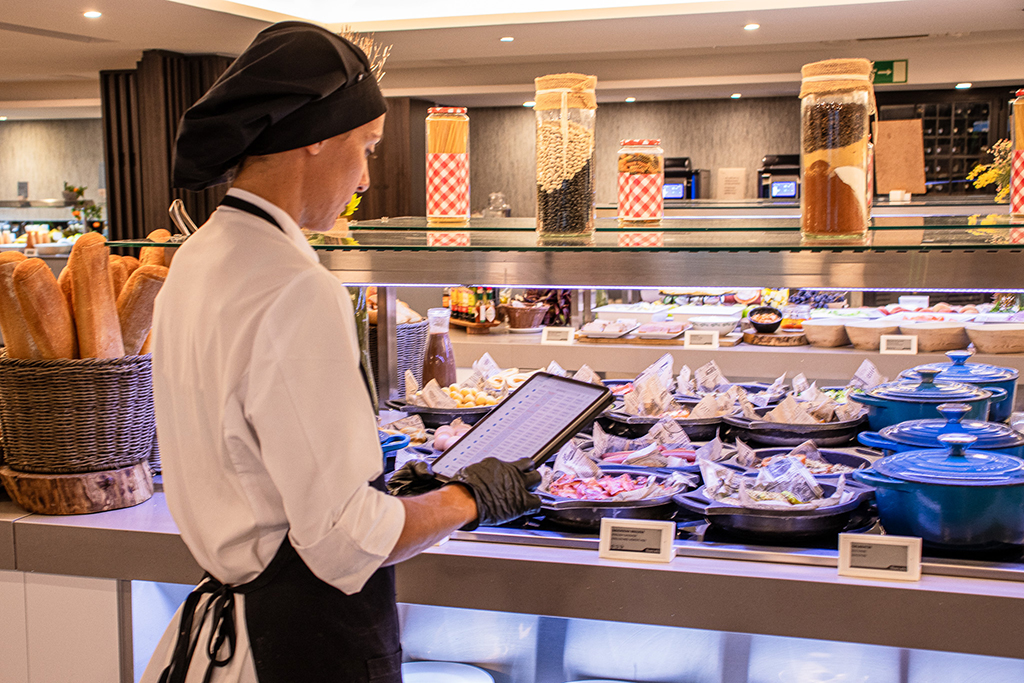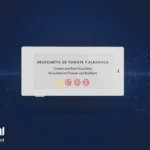In hotels, the buffet is much more than a gastronomic service: it is a showcase of the brand and a critical touchpoint in the guest experience. Every sign, every detail, influences how the quality and care of the establishment are perceived.
Until recently, managing buffet signage was a manual process: printing, laminating, placing, and replacing labels every day. A repetitive task that consumed time, generated errors, and added invisible costs to operations.
Today, with more demanding guests, stricter regulations, and an increasingly competitive sector, maintaining this dynamic is no longer sustainable. This is where digital buffet labeling comes into play—a solution that allows you to manage all information in a centralized, agile, and transparent way.
More than just a technological tool, it is a strategic ally for F&B and Operations departments: it improves efficiency, ensures food safety, and provides guests with a modern and reliable experience.
What is digital buffet labeling?
Digital labeling replaces paper signs with electronic labels connected to centralized software. They display clear and always up-to-date information: dish name, description, allergens, and translations into multiple languages.
How it works technically
The digital labeling system consists of three main pillars: electronic labels, the connectivity antenna, and the cloud software.
Electronic labels are designed to withstand buffet conditions: steam, grease, heat, and constant handling. They do not require plugging in or frequent charging, as they have a lifespan of up to seven years, ensuring stability and low maintenance.
At the heart of the system is connectivity. An antenna installed in the buffet area acts as a bridge between the labels and the management platform. This ensures that any change made in the software—such as modifying an allergen, adding a dish, or translating a name—appears within seconds on all screens.
The cloud software is the brain of the solution. From a computer, tablet, or even a mobile phone, kitchen or F&B staff can centralize information, schedule menus in advance, and manage multiple buffets simultaneously. For hotel chains, this brings an added advantage: menus across different properties can be coordinated in a unified way, without duplicating efforts.
Finally, the system offers customizable designs, adapted to the visual identity of each hotel. This not only reinforces brand consistency but also ensures the buffet looks professional and aligned with the corporate image.
Direct benefits for hotels
Implementing a digital labeling system transforms buffet operations and generates benefits at multiple levels:
- Operational efficiency: what used to take hours of daily printing, laminating, and placing, is now solved in seconds with a single click. Staff can spend more time on guest service and less on repetitive tasks.
- Food safety: by centralizing information and updating it in real time, errors in allergen management are reduced—critical for both compliance and guest trust.
- Transparency and guest experience: guests find clear, legible information in their language. This conveys professionalism, trust, and makes dish selection easier, especially in an international context.
- Real sustainability: by eliminating thousands of printed and laminated signs every month, hotels reduce their ecological footprint, aligning with environmental policies increasingly valued by travelers.
- Short-term profitability: savings in materials and labor allow the investment to be recovered in less than a year. Additionally, the impact on guest perception contributes to improved reputation and differentiation in a highly competitive market.
Practical example: the hidden cost of paper
When we talk to operations managers, the first reaction is often to think that a digital system is a high investment. However, the truly costly part is maintaining manual signage.
In a 200-room hotel, traditional management involves printing, laminating, and placing more than 10,000 labels per month. Added to this are the staff hours dedicated to repetitive work, errors in information that can cause issues with guests, and the environmental impact of continuous paper and plastic use.
The result: dozens of hours of unproductive work and several thousand euros per year in hidden costs.
With Buffetsmart, all that burden disappears. Changes are made in seconds from the app, with no need to reprint anything. The estimated savings are between €3,000 and €5,000 per year, allowing the investment to be recovered in less than 12 months.
Beyond the numbers, the benefit is strategic: a safer, more agile, and more professional buffet that builds trust with both guests and staff.
A real story: the change seen from the kitchen
Recently, the executive chef of one of our hotels shared his experience with us. Before working with Buffetsmart, the hotel spent about 30 minutes a day placing manual signage. If there was a recipe change or a new dish, the information quickly became outdated—posing risks in terms of allergens and guest trust.
Today, thanks to Buffetsmart, the situation is completely different. From his own mobile phone, he can update dish information, add new items, or modify allergens in seconds. “It’s as simple as opening the app and making the change; within seconds the buffet labels display the correct information,” he told us.
The system was designed with the daily work of F&B teams in mind: it streamlines operations, optimizes resources, and ensures processes and regulations are met without friction. The result is a more agile, safe, and professional buffet that conveys trust to both guests and employees.
Switching from paper to digital labeling is not just a technological update: it is a strategic commitment to efficiency, safety, and guest satisfaction. With our Buffetsmart solution, hotels reduce hidden costs, gain agility in operations, and strengthen their image of innovation and attention to detail. In such a competitive sector, taking this step is not a future option—it is a key decision today to stand out and offer guests a dining experience that meets their expectations.









